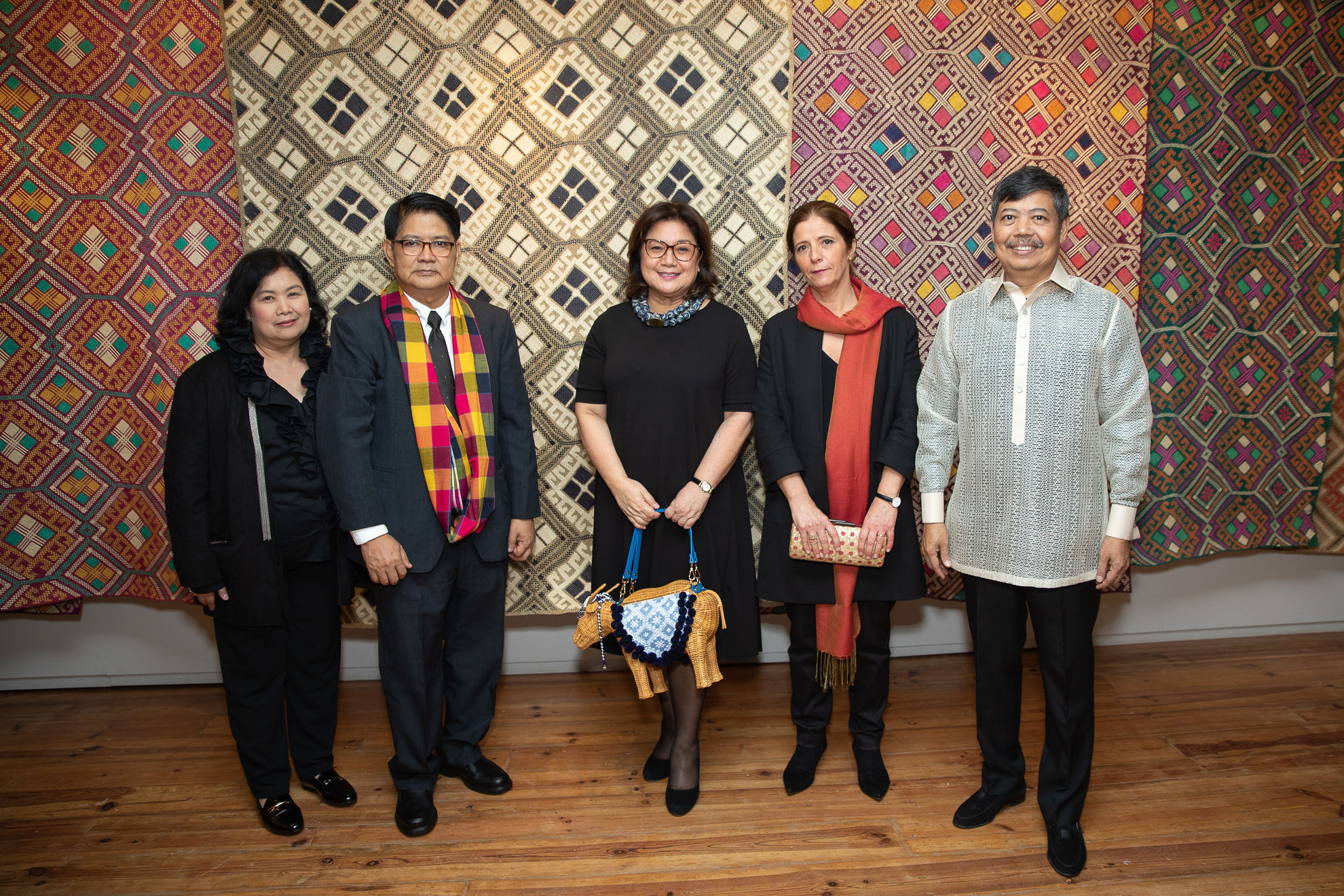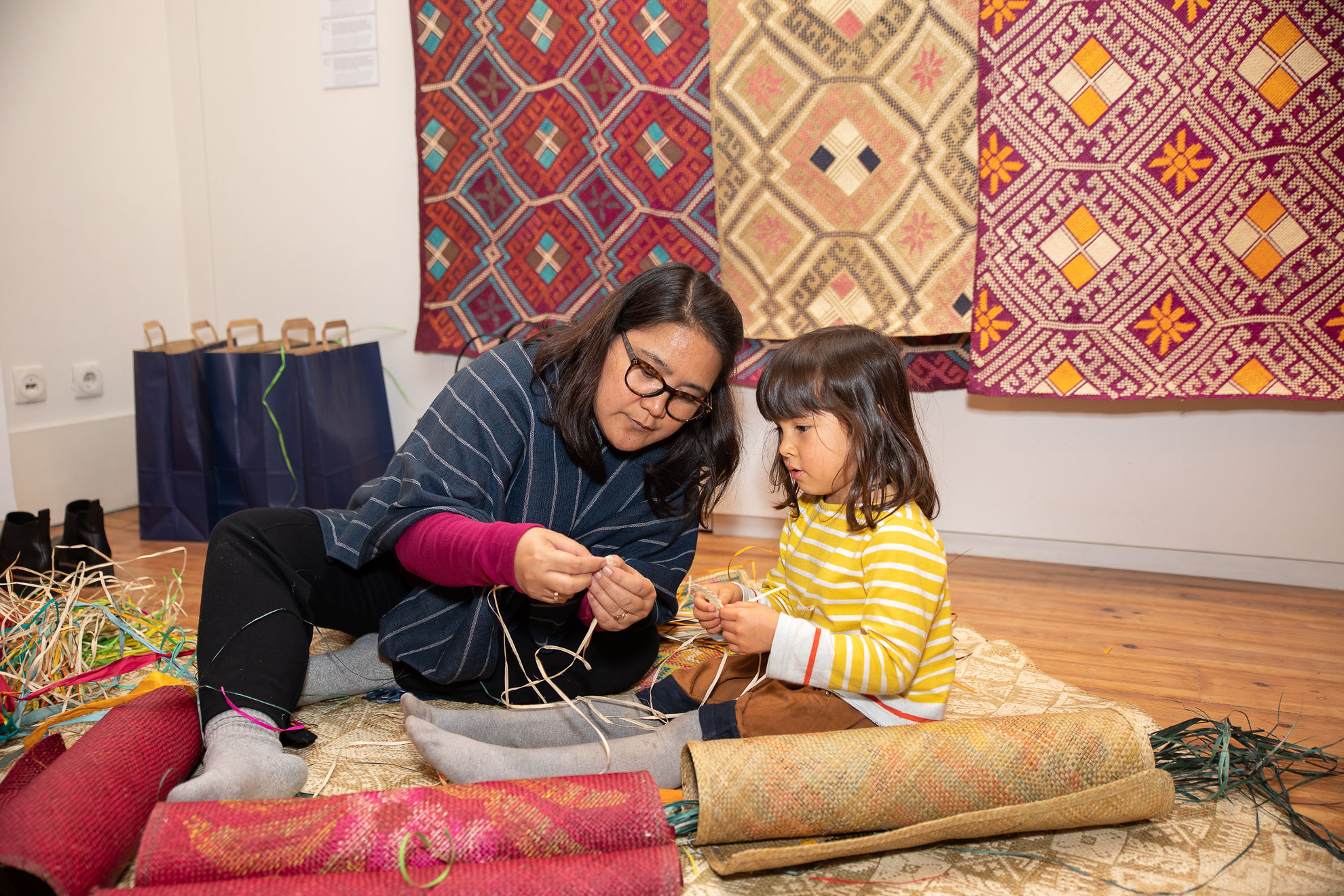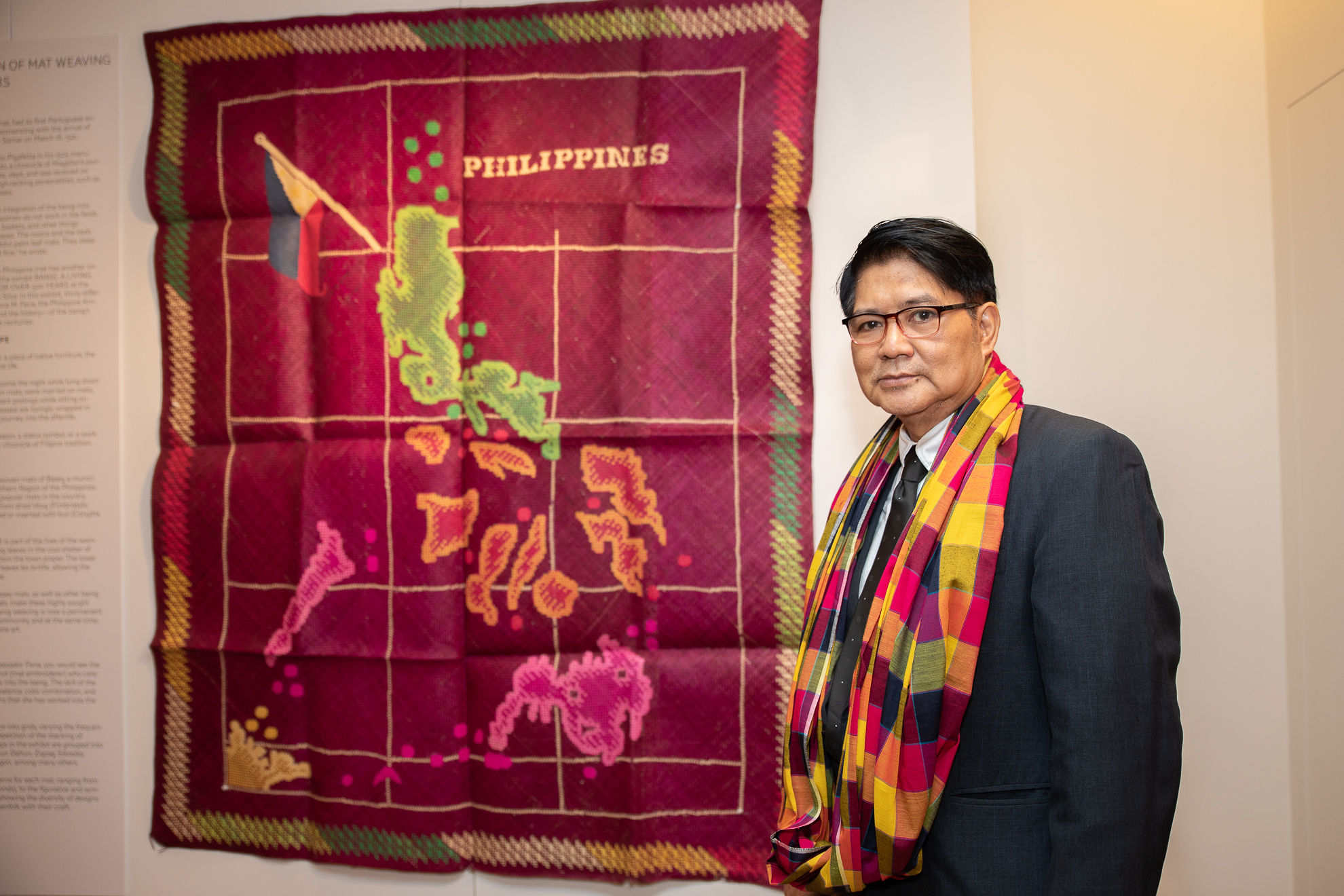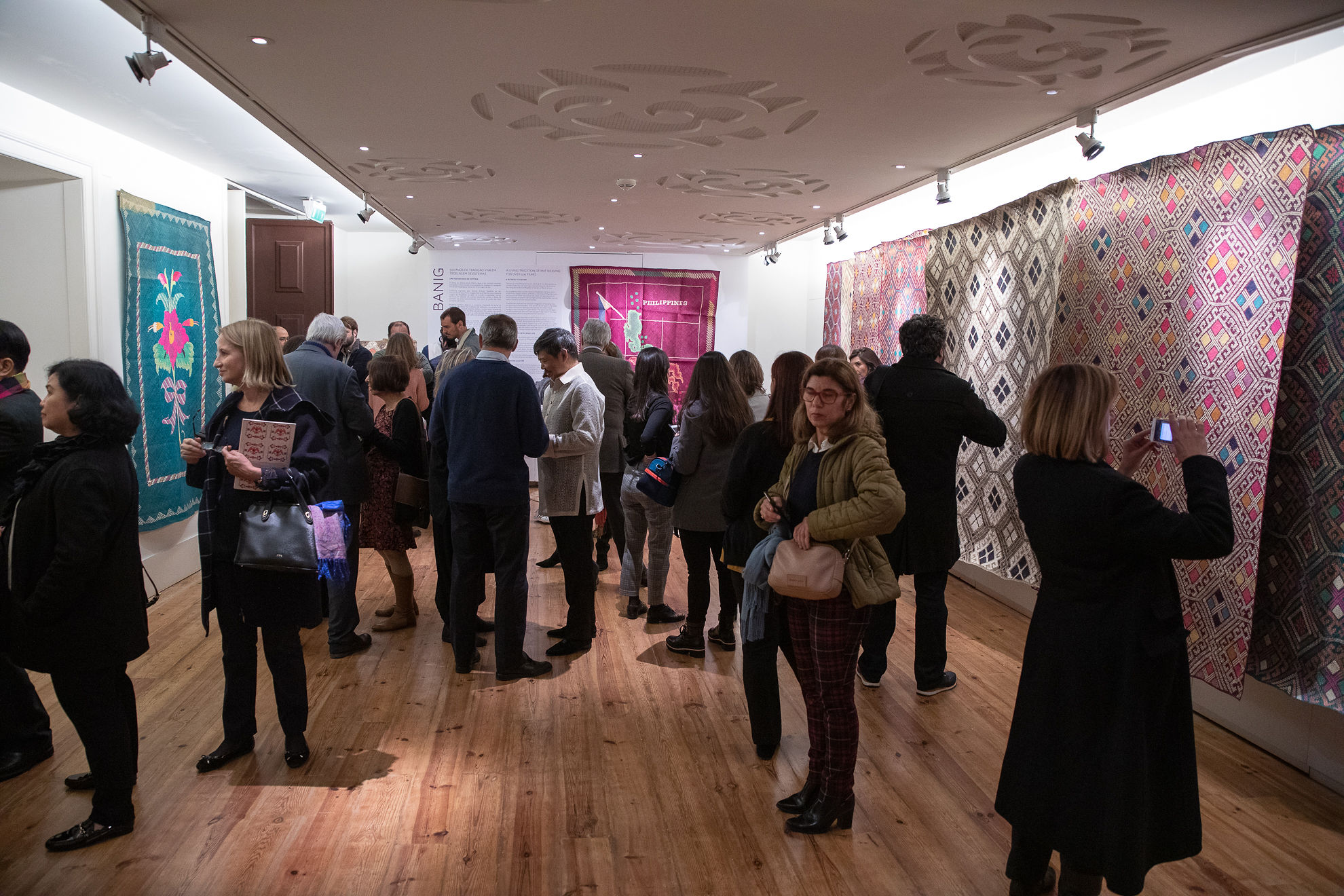
(from left to right) Dr. Noemi Nocheseda, Philippine historian, Mr. Elmer Nocheseda, Philippine Ambassador to Portugal Celia Anna M. Feria, FRESS Executive Administrator Ms. Conceiçāo Amaral, and Philippine curator Mr. Albert Avellana
27 November 2019, LISBON – In line with the cultural and economic diplomacy initiative of the Philippine Embassy in Lisbon to continue to promote the Philippine cultural identity and entrepreneurship in Portugal and to also commemorate the 500th Anniversary of the Circumnavigation of the World by the Magellan/Elcano expedition, an exhibition entitled “Banig: A Living Tradition of Mat Weaving for over 500 Years”, was held at the Fundaçāo Ricardo Espirito Santo Silva (FRESS), a decorative arts museum in the heart of Alfama, Lisbon on 21 November. The Banig Exhibit will run till 6 January 2020.
In her opening remarks, Ms. Conceição Amaral, Executive Administrator of Fundaçāo Ricardo Espirito Santo Silva (FRESS) expressed her appreciation to the Philippine Embassy for choosing FRESS as the venue for the banig exhibition and hoped the exhibition would be the beginning of many shared activities with the Embassy.
This was followed by the remarks of the Philippine Ambassador to Portugal Celia Anna M. Feria who thanked FRESS for helping the Philippine Embassy organize the banig exhibition in Lisbon. Ambassador Feria further added “Our humble banigs are displayed beside your exquisite Azulejos gold gilded furniture and lights, bright glass mirrors, and beautiful inlaid wood furniture. Side by side, our traditions are on display in the grand halls of this historic building. No longer is the banig a humble floor mat, it now proudly hangs for all to admire.”

Ms. Eva Marie Adona-Yu (left), banig weaver demonstrates the weaving process to young Fil-Portuguese Siraya Yasay-Ribeiro
Banig historian, Mr. Elmer Nocheseda traced historical accounts of Italian chronicler Antonio Pigafetta’s 1525 manuscript Primo Viaggio Intorno ad Mondo, concluding that the banig or Philippine mat played an important role in receiving Portuguese born explorer Ferdinand Magellan by local chieftains in what are now the Philippine islands of Cebu more than 500 years ago. Pigafetta cited in several occasions that Magellan ate, slept and was warmly received on the banig. Today, the banig is not only an iconic symbol of Philippine culture but also a representation of Filipino hospitality.
After 500 years, the banig has come full circle with an exhibition in Portugal showcasing banigs from Basey, a municipality in Samar, an island in the southern region of the Philippines. The banigs displayed at the presented the rich weaving tradition of the women in Basey as well as the role the banig played in Philippine culture throughout the centuries. Sedge grass or tikog is used by the women of Basey to weave a variety of designed mats, wall decors, room dividers, ceiling panels, furniture matting, place mats, throw pillows and bags.
The Basey banigs at the exhibition are also an embodiment of the resilience of the Basey women weavers who continued their weaving tradition despite the various challenges to the community and individuals brought on over the years, and most recently by Typhoon Haiyan in November 2013. The town of Basey was among the 6 hardest hit localities of the typhoon, bringing destruction to the community and its surroundings. In the face of the tragedy, the strong-willed women of Basey remained determined to reconstruct their homes and their lives.

Mr. Elmer Nocheseda, Philippine historian shows the Philippine map made of banig.
Guests who attended the exhibition were treated with a weaving demonstration by Basey based and fourth-generation artisan Ms. Eva Marie Adona-Yu who showed the intricate art weaving tradition of Basey. Portuguese artisans appreciated the complex process of banig weaving and saw the cultural similarities it has with a similar Portuguese craft as well as the banig’s decorative and multi-functional purpose.
The exhibit’s curator is Albert Avellana, artist and gallery owner in the Philippines. Mr. Elmer Nocheseda, a historian and author of several books on history’s weaving arts, including Rara: Art and Tradition of Mat Weaving in the Philippines provided the rich historical contextualization to the exhibit.
Banig historian, Mr. Elmer Nocheseda traced historical accounts of Italian chronicler Antonio Pigafetta’s 1525 manuscript Primo Viaggio Intorno ad Mondo, concluding that the banig or Philippine mat played an important role in receiving Portuguese born explorer Ferdinand Magellan by local chieftains in what are now the Philippine islands of Cebu more than 500 years ago. Pigafetta cited in several occasions that Magellan ate, slept and was warmly received on the banig. Today, the banig is not only an iconic symbol of Philippine culture but also a representation of Filipino hospitality.
After 500 years, the banig has come full circle with an exhibition in Portugal showcasing banigs from Basey, a municipality in Samar, an island in the southern region of the Philippines. The banigs displayed at the presented the rich weaving tradition of the women in Basey as well as the role the banig played in Philippine culture throughout the centuries. Sedge grass or tikog is used by the women of Basey to weave a variety of designed mats, wall decors, room dividers, ceiling panels, furniture matting, place mats, throw pillows and bags.
The Basey banigs at the exhibition are also an embodiment of the resilience of the Basey women weavers who continued their weaving tradition despite the various challenges to the community and individuals brought on over the years, and most recently by Typhoon Haiyan in November 2013. The town of Basey was among the 6 hardest hit localities of the typhoon, bringing destruction to the community and its surroundings. In the face of the tragedy, the strong-willed women of Basey remained determined to reconstruct their homes and their lives.
The exhibition will run from 21 November 2019 to 6 January 2020 at the Sala dos Chavões of FRESS. Members of the diplomatic corps, Portuguese government and museum officials, members of the Filipino community, art enthusiasts and designers attended the opening of the exhibition.

Guests at the banig exhibition at Fundaçāo Ricardo Espirito Santo Silva (FRESS) in Lisbon

